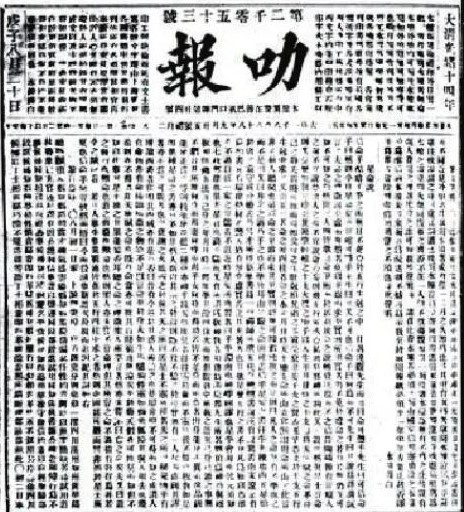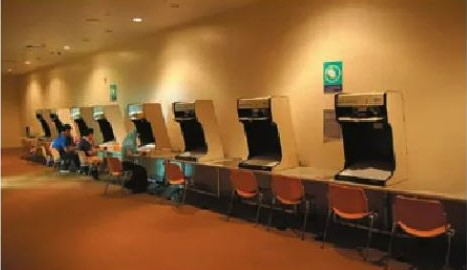Microfilm Collection and Services in the Lee Kong Chian Reference Library
Microfilming the National Library’s collections began in the 1950s to preserve and archive Singapore’s documentary heritage. The collection includes newspapers; rare and out-of-print books; periodicals and directories; government publications; and dissertations.
Microfilming the National Library’s collections began in the 1950s. It was initiated as a move to preserve and archive Singapore’s documentary heritage. Beginning with a collection of old newspapers and manuscripts, microfilming activities was stepped up to include the filming of government records, as well as rare and out-of-print Singapore materials.
Over the years, this collection was further enhanced through the addition of titles acquired from the British Library, Malaysian libraries, National University of Singapore Library, University Microfilms International and the Library of Congress. Today, the collection has grown to an extensive archive of 24,000 microfilm reels and 12,500 fiches that forms an integral part of the Singapore and Southeast Asian collections at the Lee Kong Chian Reference Library.
The collection, housed at Level 11 of the Lee Kong Chian Reference Library, is an invaluable and rich resource to many users, from the researcher of Singapore history, the student conducting social and business research, the heritage seeker pouring through Singapore’s earliest imprints and Jawi manuscripts, to the individual tracing his family roots.
The microform collection can be broadly categorised into newspapers, rare and out-of-print books, periodicals and directories, government publications and dissertations.
Newspapers
The most popularly used resource is the newspaper archives. The collection comprises approximately 100 Singapore/Malayan newspapers dating back to 1827 with the publication of Singapore Chronicle and Commercial Register (1827–1937). In addition to the English newspapers, papers in the vernacular, namely Chinese, Malay/Jawi, and the Indian languages (Tamil/ Malayalam/ Punjabi) are also represented.
The English-language press sources include major papers namely The Singapore Free Press (1835– 1869, 1884–1962), The Straits Times (1845–), The Singapore Daily Times (1865–1882), The Malaya Tribune (1914–1951), The Syonan Shimbun (1942–1945), Singapore Standard (1950–1959) and The Singapore Herald (1970–1971) amongst others. The collection also contains a host of short-lived papers such as Times of Malaya (1938–1939) and Eastern Daily Mail (1905–1908) which appeared during the early 20th century; The Eastern Sun (1966–1971) and New Nation (1971–1982) in the 1960s–70s; The Singapore Monitor (1982–1985) in the 1980s and more recently, Project Eyeball (2000–2001) and Streats (2003–2004). The library also acquires Malaysian newspapers with bearings on the history of Singapore. An example is The Malay Mail (1896–1981) which carried news on federal proceedings in Kuala Lumpur.
The early English papers catered to the European reader and were largely commercial in orientation. Common features include shipping news, commodity prices, commercial activities, advertisements and social news. It was only with the establishment of Singapore Daily Times, the second English daily in Singapore, that the press began to engage more deeply into politics. International news also increased in numbers and scope with The Straits Times subscription of the Reuters News Agency in 1870.
By the early 20th century, non-Europeans had established a number of English papers. One of the more successful ventures was The Malaya Tribune which was strong competitor to The Straits Times. Supported by Dr Lim Boon Keng and a group of prominent Chinese and Eurasians, The Malaya Tribune aimed “to express the views and aspirations of the domiciled communities”.
In the 1970s, the delicate political situation of post-independent Singapore saw the closure of a number of newspapers like The Eastern Sun and The Singapore Herald. In recent times, attempts have been made to diversify the newspaper business and to liberalise the Singapore media scene through the introduction of new papers like The Singapore Monitor, The New Paper (1988–), an afternoon tabloid, Project Eyeball which targeted the young, educated and savvy readers, and commuter papers like Streats (2003) and Today (2000–). All have since ceased publication, with the exception of The New Paper and Today.
Mirroring the increased development of Singapore, the vernacular presses flourished during the 1870s when the Straits Settlements came under the direct rule of the Colonial Office in London in 1867. The Library’s holdings of Malay newspapers include the first Malay newspaper published in Malaya, the Jawi Peranakan (1876–1895). Edited by Mohameed Said bin Dada Mahyiddin, a Penangborn Indian Muslim and teacher at the Raffles Institution, the paper was credited with raising the social awareness of the Malay community and promoting Malay education and language. Other titles in the collection include: Lembaga Melayu (1914–1931), a forward-looking and temperate newspaper which enjoyed a following amongst the urban middle-class Malays. The paper was edited by Mohammad Yunos bin Abdullah who is widely acknowledged as the father of Malay journalism; and Warta Malaya (1930–1941), an important vehicle for the discussion of Malay affairs, founded by the Alsagoff family and edited by Onn bin Jaafar who became one of the foundes of UMNO in 1951. Also within the Library’s collection is one of the most complete runs of Utusan Melayu for the period 1945–1998 held in any Singapore library. Utusan Melayu, revived in 1938 by Yusof bin Ishak, Singapore’s first Presidents, was the leading Malay newspaper in Singapore and Malaya after the war.

The Library’s collection also houses a rich selection of Chinese newspapers. It includes Le Bao (commonly known as Lat Pau) widely acknowledged as the first Chinese newspaper in Singapore. The Library’s holdings cover the period 1887–1932. Other leading Chinese newspapers also available are: Xing Bao [星报] (1890–1898), Tian Nan XIn Bao [天南新报] (1898–1905), Jih Hsin Pao [日新报] (1899–1901), Zhong Hui Xin Bao (Union Times) [中汇新报] (1906–1946), Zhong Xing Ri Bao [中兴日报] (1907–1957). These papers represented a variety of viewpoints and editorial stances concerning the events which were taking place in China. Earlier papers like Le Bao were generally conservative papers which supported the Manchu and British governments. Later papers positioned themselves as progressive publications which promoted reformation within the Chinese community. Chinese nationalism, Confucianism and even-pro-revolutionary ideas. The other two major Chinese newspapers in the Library’s collections are the Nanyang Siang Pau [南洋商报] (1923–1983) started in 1923 by Tan Kah Kee and Sin Chew Jit Poh [星洲日报] by “Tiger Balm King” by Aw Boon Haw in 1929.
The Library’s microfilm collection also contains Indian newspapers. Singai Nesan (1887–1890) was published in 1887 by Makadoom Saiboo to commemorate the Queen Victoria Silver Jubilee celebrations. Kerala Bandhu (1938–1964) and Najwan (1955–1976) are thought to be the only Malayan and Punjabi newspapers serving Malayan region respectively. Though many of the newspapers dealt with the news and concerns back home in India, they also provided an important avenue for creative and literary expressions, thereby fostering the birth and development of Singapore literature.

Today, the Library continues to film and archive all locally produced newspapers such as The Straits Times, The Business Times, The New Paper, Today, Lianhe Zaobao, Lianhe Wanbao, Shin Min Daily, Berita Harian, Tamil Murasu and youth papers like Friday Weekly and Thumb Up Weekly.
Rare and Out-of-Print Books, Periodicals, Directories and Government Publications
Substantial volumes of the Library’s rare materials as well as its pre-1970 Singapore imprints were also microfilmed. These comprise materials from Singapore’s earliest mission presses, religious tracts, Jawi manuscripts, Peranakan literature, travelogues, scholarly journals and entertainment magazines, business directories and almanacs, Malayan maps, language dictionaries and even school textbooks. Some of these gems include Addresses etc. Presented to Mr. Raffles, on the Occasion of His Departure from Java (1817), Singapore Local Laws and Institutions (1823), A Vocabulary of the English, Bugis, and Malay Languages (1833), The Maritime Code of the Malays (1877), Jottings Made During a Tour Amongst the Land Dyaks of Upper Sarawak, Borneo, During the Year 1874 (1879), and many others. These collections are extremely valuable for historical research on Singapore and Southeast Asia. Besides microfilming materials from the mission and commercial printing presses, the Library also regularly microfilms official publications such as the government gazettes, parliamentary debates, annual departmental reports and statistical publications issued by past and present governments.
Dissertations
To further develop the microfilm collection, the Library actively acquires dissertations from University Microfilms International (UMI). To date, this collection numbers around 2,000. The dissertation collection brings together post-graduate and doctoral investigations that are of social, economic, cultural, historical significance to Singapore and Southeast Asia. Some of the interesting titles include: Performing Chinese Street opera and Constructing National Culture in Singapore, British Merchant Enterprise and the Chinese Coolie Labour Trade, 1850–1874, Kota Cina: Its Context and Meaning in the Trade of Southeast Asia in the 12th to 14th centuries, Siam in British foreign policy 1855–1938: The Acquisition and the Relinquishment of British Extraterritorial Rights, amongst others.
Collection Access and Viewing Facilities
Patrons can search for titles using the Library’s online public access catalogue (OPAC), as well as the onsite microfilm newspaper index and card catalogues. The Microform Collection is largely an open-access collection with small numbers of microfiches and dissertations on microfilm kept in closed access areas. For open access collections, patrons may retrieve the microfilms themselves before proceeding to the Information Counter at Level 11 to register for the use of a microfilm reader. The microform viewing room is equipped with ten microfilm readers and one microfiche reader.
Reprographic Facilities
Reprographic prints can be made at the photocopying facility at Level 11. The current charges are $0.60 for A4 size and $0.90 for A3 size plain paper. Patrons may also place orders for reprographic prints on photographic paper at the Information Counter.

